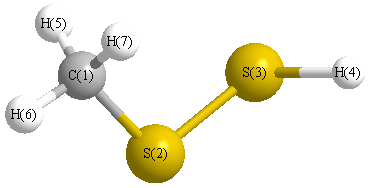Vibrational Frequencies calculated at TPSSh/cc-pV(T+d)Z
| Mode Number |
Symmetry |
Frequency
(cm-1) |
Scaled Frequency
(cm-1) |
IR Intensities
(km mol-1) |
Raman Act
(Å4/u) |
Dep P |
Dep U |
|---|
| 1 |
A |
3136 |
3136 |
7.93 |
|
|
|
| 2 |
A |
3118 |
3118 |
7.35 |
|
|
|
| 3 |
A |
3034 |
3034 |
18.53 |
|
|
|
| 4 |
A |
2620 |
2620 |
8.68 |
|
|
|
| 5 |
A |
1488 |
1488 |
7.59 |
|
|
|
| 6 |
A |
1467 |
1467 |
7.47 |
|
|
|
| 7 |
A |
1343 |
1343 |
4.54 |
|
|
|
| 8 |
A |
971 |
971 |
5.49 |
|
|
|
| 9 |
A |
966 |
966 |
3.16 |
|
|
|
| 10 |
A |
883 |
883 |
5.28 |
|
|
|
| 11 |
A |
686 |
686 |
1.74 |
|
|
|
| 12 |
A |
511 |
511 |
0.72 |
|
|
|
| 13 |
A |
350 |
350 |
12.99 |
|
|
|
| 14 |
A |
234 |
234 |
0.19 |
|
|
|
| 15 |
A |
161 |
161 |
0.42 |
|
|
|
Unscaled Zero Point Vibrational Energy (zpe) 10483.0 cm
-1
Scaled (by 1) Zero Point Vibrational Energy (zpe) 10483.0 cm
-1
See section
III.C.1 List or set vibrational scaling factors
to change the scale factors used here.
See section
III.C.2
Calculate a vibrational scaling factor for a given set of molecules
to determine the least squares best scaling factor.
Charges, Dipole, Quadrupole and Polarizability
Charges from optimized geometry at TPSSh/cc-pV(T+d)Z
Charges (e)
| Number |
Element |
Mulliken |
CHELPG |
AIM |
ESP |
| 1 |
C |
-0.192 |
|
|
|
| 2 |
S |
-0.071 |
|
|
|
| 3 |
S |
-0.103 |
|
|
|
| 4 |
H |
0.080 |
|
|
|
| 5 |
H |
0.105 |
|
|
|
| 6 |
H |
0.086 |
|
|
|
| 7 |
H |
0.094 |
|
|
|
Electric dipole moments
Electric dipole components in Debye
(What's a Debye? See section
VII.A.3)
| |
x |
y |
z |
Total |
| |
-1.055 |
1.206 |
0.787 |
1.784 |
| CHELPG |
|
|
|
|
| AIM |
|
|
|
|
| ESP |
|
|
|
|
Electric Quadrupole moment
Quadrupole components in D Å
Polarizabilities
Components of the polarizability tensor.
Units are
Å
3 (Angstrom cubed)
Change units.
| |
x |
y |
z |
| x |
10.032 |
0.250 |
0.173 |
| y |
0.250 |
6.685 |
0.090 |
| z |
0.173 |
0.090 |
5.794 |
<r2> (average value of r
2) Å
2
| <r2> |
102.061 |
| (<r2>)1/2 |
10.103 |
